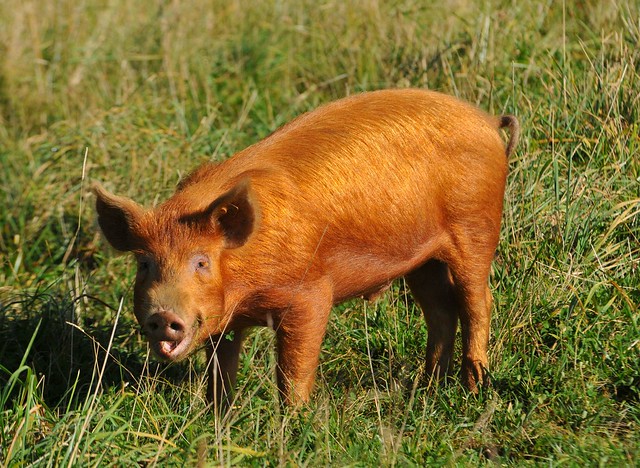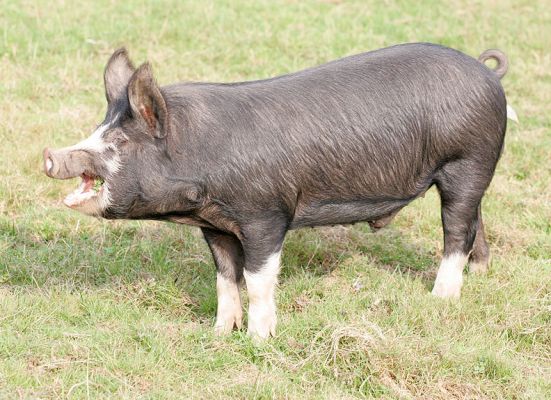Pigs have been a staple of the American farm for as long as anyone can remember. But how many people have seen a production pig (not in a petting zoo) in a field? How many people think pigs do NOT smell? Big agriculture has given pigs a horrible name.
Pigs, at a minimum, belong outdoors. They deserve to have enough space to move around and not be wallowing in feces waiting for a person (note I didn't say farmer) to hose down whatever cement pad he has them on. They deserve to wallow in mud, to feel the sun on their backs and to not fight for every bit of food that comes their way. They deserve to keep their tails. They deserve to be contagiously happy. We think you'll agree after one visit to our farm that the pigs are the sweetest animals on the farm.
We visited a farm a while ago that changed are viewpoint toward pigs and for that we are ever grateful. Ben and Kelly Dean, of Savannah River Farms, in Newington, GA, are outstanding farmers. Imagine a field no bigger than 3 acres of 300 hogs of various sizes from 60 pounds to over 1000 pounds. You would think it would stink to high heaven, everything would be torn to shreds and the air would be filled with shrills, shrieks, screams, and fighting. Never having met us before, they were extremely personable and answered a thousand questions and gave plenty of advice. Then they put my family of 5 on their ATV and drove us right into their current pig paddock. Not a single pig tried to jump up on us. There was NO smell other than the trees. Grass was all over. Some pigs were laying in the mud; others enjoying shade under a few trees. We saw no bite marks, heard no shrieks, and they all had their tails. And funny thing is, she had said the hogs were their most profitable animal.
There are just over a dozen common hog species in the United States. Most of the ones big agriculture uses have been selectively bred over the years to get bigger and bigger on less feed and tolerate worse living conditions. They will not do well under little supervision and out on pasture. We will be using breeds from the American Livestock Breed Conservancy - an organization aiming to preserve older genetics and species from America's golden farm days. These species need very little to no assistance in giving birth, feeding their young, producing enough milk for their young, foraging for food, understanding when to shelter from inclement weather, and they are more resistant to diseases and parasites. Many also are much much leaner and therefore, healthier for the consumer. People who associate fat with flavor need to understand that meat produce on pasture will have flavor in the meat itself and therefore, when cooked slowly, need not have fat.
Initially we will have Tamworth hogs and start with purebred hogs. We would like to help preserve this endangered breed if only for 2 or 3 years before crossing or hogs with a Duroc or Berkshire boar. There are several other breeds piquing our interest such as the Large Black, the Hereford, Mangalitsa and the Chester White. Many of these breeds in addition to being what farmers call "hardier," are tamer by nature, which is important to us since we will be having so many farm visitors. Their calm and friendly nature attracts children, instead of terrifying them and as a result, shutting down the capacity for intrigue and learning about the farm.
 |
| Gorgeous Tamworth Boar |
 |
| Juvenile Tamworth |
 |
| The esteemed Berkshire. Their meat is considered the "Kobe Pork." It is much darker and extremely flavorful. |
 |
| Duroc- a very hard pasture type pig |
 |
| Large Black- very hardy, great mothers, eats more grass than other hogs. |
We will be rotating our hogs (once we get our own land) through woods and small pasture paddocks in conjuction with goats and chickens. Other than producing meat, the hogs will be used to "hog down" our corn crop after we harvest the ears of corn. They will also be used to "till" our winter animal housing. We are going to throw grains down in the bedding of our over-wintering houses every time we add new bedding. When we release the normal animals to the other pastures, we send a few pigs in to "pigaerate" term coined by Joel Salatin - as they hunt for grains. As they aerate the soil, they change the compost from anaerobic (supports dangerous pathogens) to aerobic supporting the helpful bacteria that break down the compost and prepare it for use in the fields. My intent is to have such tame hogs that farm visitors can come out to the field and pet them with no fears.





No comments:
Post a Comment